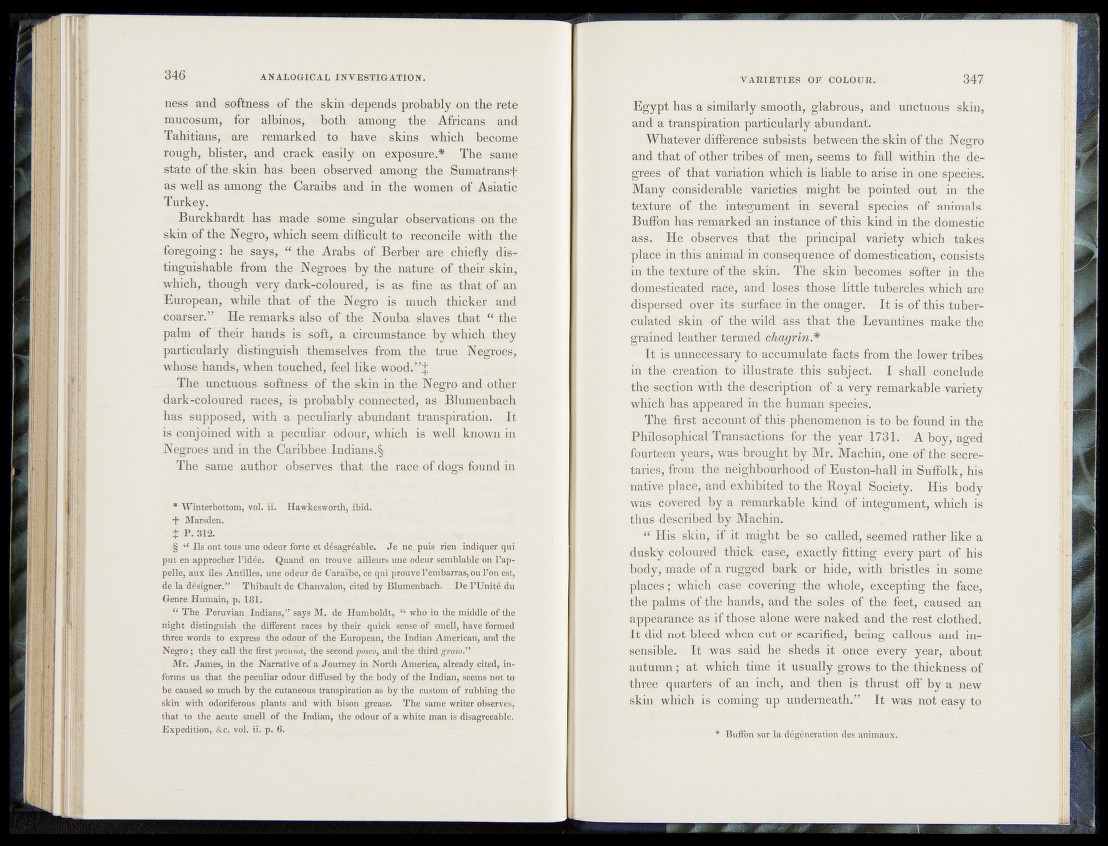
ness and softness of the skin depends probably on the rete
mucosum, for albinos, both among the Africans and
Tahitians, are remarked to have skins which become
rough, blister, and crack easily on exposure.* The same
state of the skin has been observed among the Sumatrans^
as well as among the Caraibs and in the women of Asiatic
Turkey.
Burckhardt has made some singular observations on the
skin of the Negro, which seem difficult to reconcile with the
foregoing: he says, “ the Arabs of Berber are chiefly disr
tinguishable from the Negroes by the nature of their skin,
which, though very dark-coloured, is as fine as that of an
European, while that of the Negro is much thicker and
coarser.” He remarks also of the Nouba slaves that “ the
palm of their hands is soft, a circumstance by which they
particularly distinguish themselves from the true Negroes,
whose hands, when touched, feel like wood.v+
_ The unctuous softness of the skin in the Negro and other
dark-coloured races, is probably connected, as Blumenbachr
has supposed, with a peculiarly abundant transpir atjojnu j I t
is .conjoined with a peculiar odour, which is well'known in
Negroes and in the Caribbee. Indians.^
The same author observes that the„race o f dogs'found in • *
§• Wïnterbottom, voL ii. Hawkesworth, ibid.
-f* Marsden.
t P- 312.
§ “ Ils ont tous une odeur forte et désagréable. Je ne. pais rien indiquer qui
put en approcher l’idée. Quand on trouve ailleurs une odeur semblable on l ’ap-
pelle, aux îles Antilles, une odeur de Caraïbe, ce qui prouve l’embarras, ou l’on est,
de la désigner.” Thibault de Chanvalon, cited by Blumenbach. De l’Unité du
Genre Humain, p. 181.
E The Peruvian,. Indians,” say? M. de Humboldt, x who in the puddle of the
night distinguish the different races by their quick sense-of smell, have formed
three words to express the odour of the European, the Indian American, and thé
Negro ; they call the first pezuna, the second posco, and the third graio.”
Mr. James, in the Narrative of a Journey in North America, already dted, informs
us that the peculiar odour diffused by the body of the Indian, seems not to
be caused so much by the cutaneous transpiration as by the custom of rubbing the
skin with odoriferous plants and with bison grease. The same writer observes,
that to the acute smell of the Indian, the odour of a white man is disagreeable.
Expedition, &c, vol. ii. p. 6.
Egypt has a similarly smooth, glabrous, and unctuous skin,
and a transpiration particularly abundant.
Whatever difference subsists between the skin of the Negro
and that of other tribes of men, seems to fall within ‘the degrees
of that variation which is liable to arise in one species.
Many cCnsiderable varieties might be pointed out in the
texture of the integument in several1 species of animals.
Buffon has remarked, an instance bf this kind in the domestic
.ass. He observer that the principal variety which takes
place in this animal in consequence o f domestication, consists
itiFthe texture of the skin. The skin becomes softer in the
domesticated fade, and loses those little tubercles which are
dispersed over its surface in the onager. It is of this tuber*
culated skin of the wild ass*: that the Levantines make the
grained leather termed chagrin.*
It isunnecessaryLto aCcumulate facts from the lowfer tribes
in the creation to illustrate this subject.- I Shall conclude
the sectidn with the description oft a very remarkable variety
which has. appeared in the humamspebies;
The first account of this phenomenon is to be found in the
PMlosbphieal'Tfansactions for the iyear >173 h A boy, aged
fourteen years, was' brought by- Mr. Machin, one-of theseere-
taries, from the neighbourhood of Euston-hall in Suffolk, his
native place, and exhibited to the Royal Society. His body
Was covered "‘fey a remarkable kind of integument, which is
thus -described by Machin.
■:'** His skin, if it* might be so called, seemed rather like a
dusky cblbured thick -case, exactly fitting every part - bft his
body, made of a rugged bark or hide, with bristles in some
places; which case covering the whole, excepting the faces,
the palrhs of the hands, and the soles of the feet, caused an
appearance as if those alone were naked and the rest clothed!
It did not bleed when cut or scarified, being callous and insensible.
I t was said, he sheds it once every year/- about
autumn; at which time it usually ‘grows- tb the thickness of
three quarters of an inch, and then is thrust off by a new
skin which is coming up underneath.” It was not easy to
• Buffon sur là dégéneration des adiièSiSÈ!